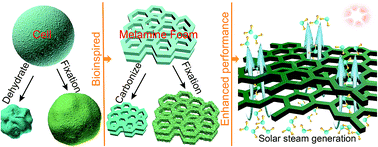Bioinspired foam with large 3D macropores for efficient solar steam generation†
Abstract
Although numerous solar steam generation devices have been developed to remit energy and environmental crisis, challenges remain owing to restrained vapor transport in the devices and high cost of device fabrication. Herein, a novel “nano-fixation” strategy, inspired by biological fixation, is proposed to prepare a photothermal foam for solar steam generation in an inexpensive manner. The nano-fixation involves in situ crystallization of MoS2 nanocrystals on a melamine-derived carbon skeleton, restricting its shrinkage; this in turn yields foams with larger 3D macropores. Due to the unique structural advantages of the skeleton-fixed foam, i.e., large 3D macropores for steam transport, hydrophobicity and low density for localized heating, the hybrid foam shows a rapid water evaporation rate (1.458 kg m−2 h−1) with high energy conversion efficiency (90.4%) under 1 sun irradiation. In addition to the enhanced steam generation performance by this facile and low-cost device, the foam provides superior practical functionality as compared to many conventional photothermal devices including those employing selective oil adsorption and blocking of water leakage. More importantly, the proposed nano-fixation principle can also be applied for the preparation of Au NPs, Mo2C, or Fe/Fe3C-loaded carbon foams, thus showing great potential for various practical applications.



 Please wait while we load your content...
Please wait while we load your content...